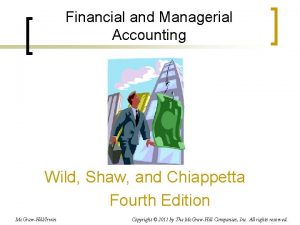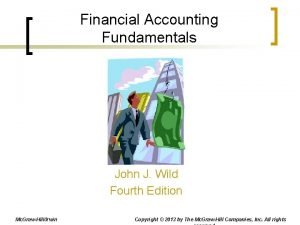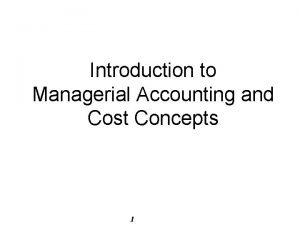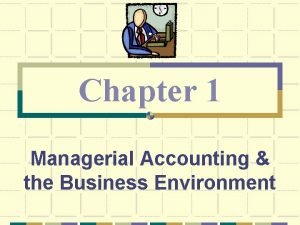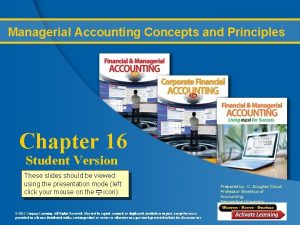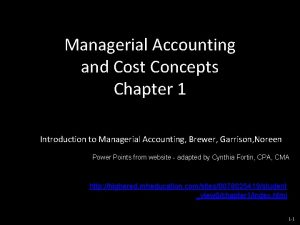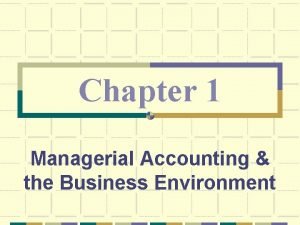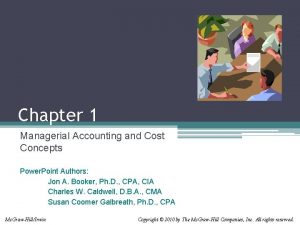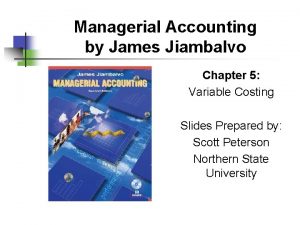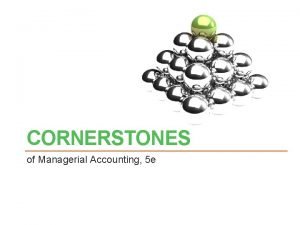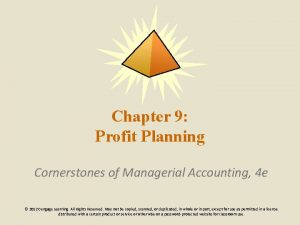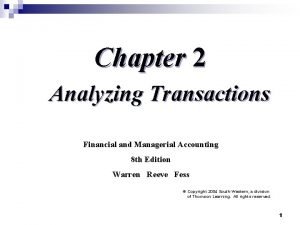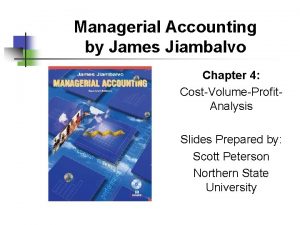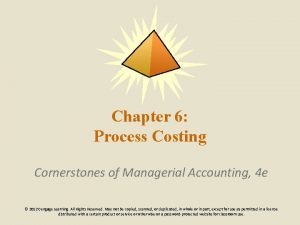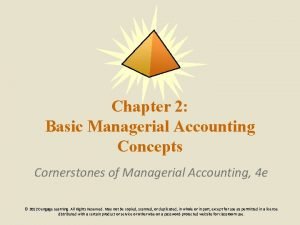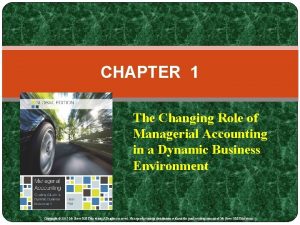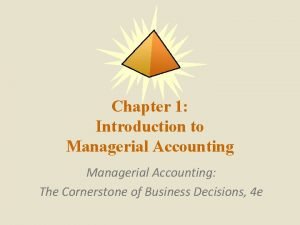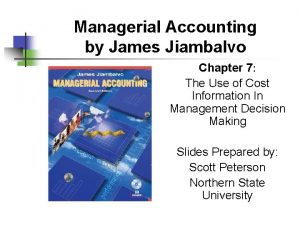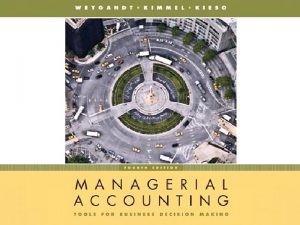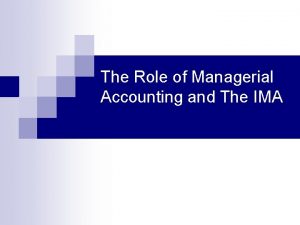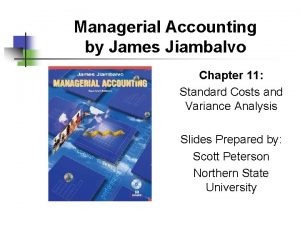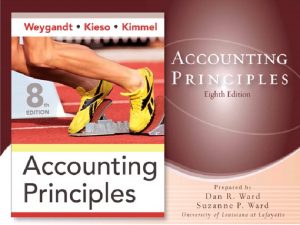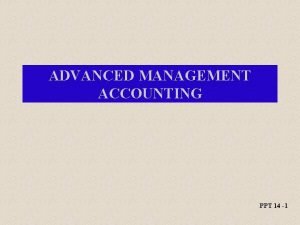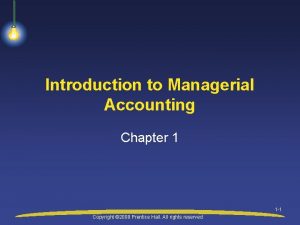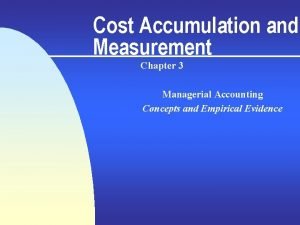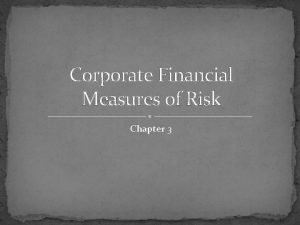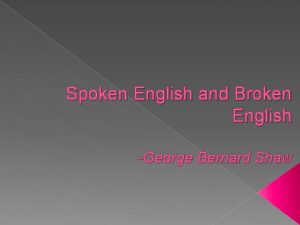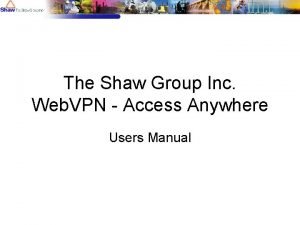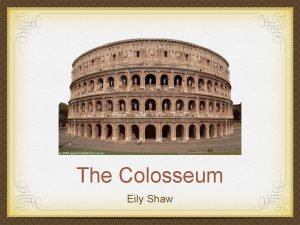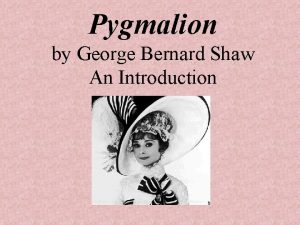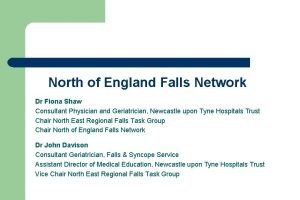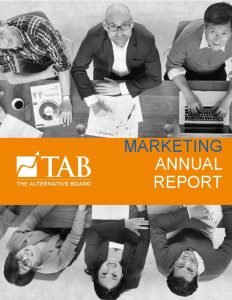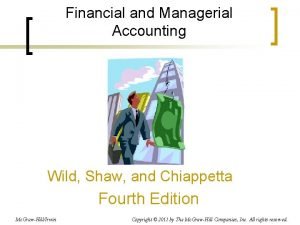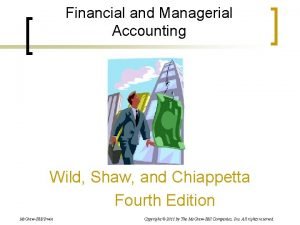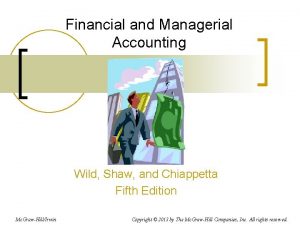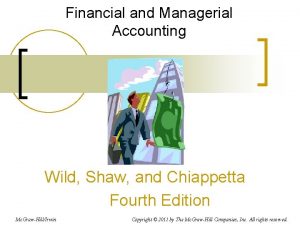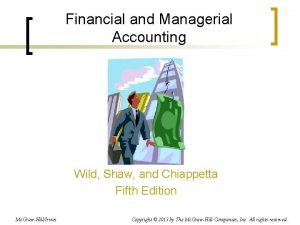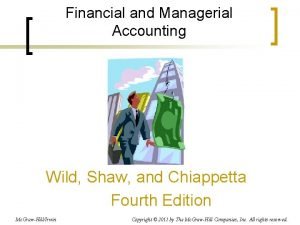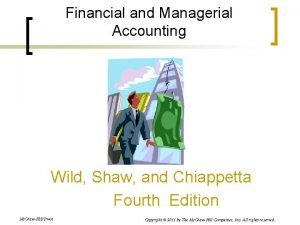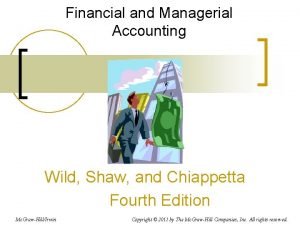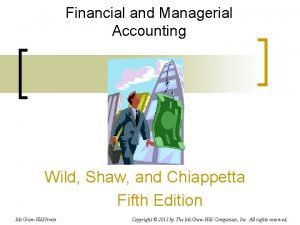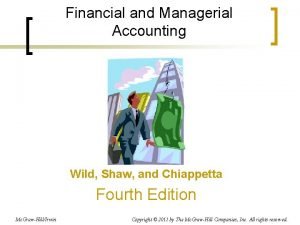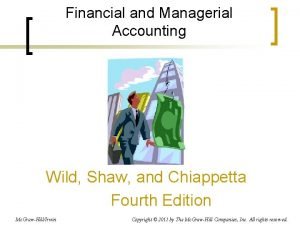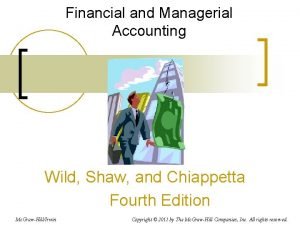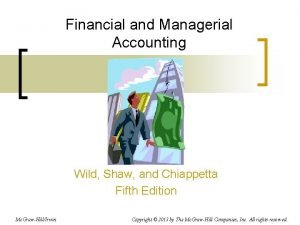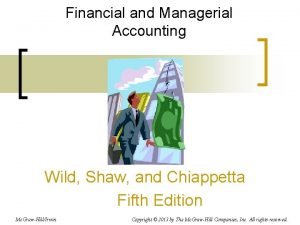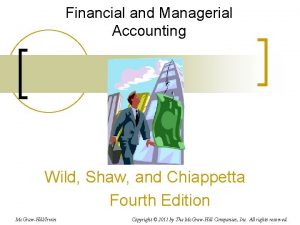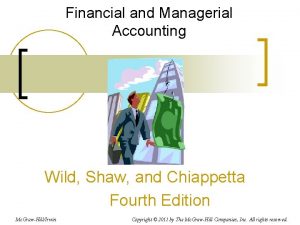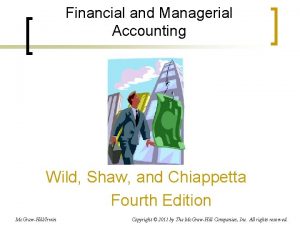Financial and Managerial Accounting Wild Shaw and Chiappetta








































- Slides: 40

Financial and Managerial Accounting Wild, Shaw, and Chiappetta Fourth Edition Mc. Graw-Hill/Irwin Copyright © 2011 by The Mc. Graw-Hill Companies, Inc. All rights reserved.

Chapter 15 Job Order Costing and Analysis

Conceptual Learning Objectives C 1: Describe important features of job order production. C 2: Explain job cost sheets and how they are used in job order cost accounting. 15 -3

Analytical Learning Objectives A 1: Apply job order costing in pricing services. 15 -4

Procedural Learning Objectives P 1: Describe and record the flow of materials costs in job order cost accounting. P 2: Describe and record the flow of labor costs in job order cost accounting. P 3: Describe and record the flow of overhead costs in job order cost accounting. P 4: Determine adjustments for overapplied and underapplied factory overhead. 15 -5

C 1 Job Order Production Process Costing Job Costing Chapter 16 u Used for production of large, unique, or high-cost items. u Built to order rather than mass produced. u Many costs can be directly traced to each job. 15 -6

C 1 Job Order Manufacturing Process Costing Job Costing Chapter 16 Typical job order cost applications: u Special-order printing u Building construction Also used in service industry u Hospitals u Law firms 15 -7

C 1 Events in Job Order Costing Receive order from customers Predict cost to complete job Schedule the production of job Negotiate a sales price and decide whether to pursue the job. 15 -8

Job Order Production Activities C 1 Indirect Materials Direct Indirect Factory Allocate Overhead Labor Direct Goods in Process Finished Goods Cost of Goods Sold 15 -9

C 2 Job Cost Sheet 15 -10

P 1 Materials Requisition C. Luther M. Bateman C. Luther 15 -11

P 1 Materials Ledger Card 15 -12

P 1 Job Cost Sheet 15 -13

P 2 Job Cost Sheet Accumulate direct labor costs by means of a work record, such as a time ticket, for each employee. Let’s see one 15 -14

P 2 Labor Time Ticket C. Luther 15 -15

P 2 Job Cost Sheet 15 -16

P 3 Job Cost Sheet Allocate manufacturing overhead to jobs using a predetermined overhead rate Let’s do it 15 -17

P 3 Job Cost Sheet 15 -18

P 3 Predetermined Overhead Allocation Rate Formula Road Warriors uses a predetermined overhead rate (POHR) based on direct labor cost to apply overhead to jobs. POHR = Estimated total manufacturing overhead cost for the coming period Estimated total direct labor costs for the coming period $200, 000 $125, 000 = 160% of direct labor $ 15 -19

P 1 Cost Flows and Documents The materials requisition indicates the cost of direct materials to charge to jobs and the cost of indirect materials to charge to overhead. Direct materials Materials Ledger Cards Requisition Indirect materials Job. Cost Job Cost Sheets Sheets Factory Overhead Account 15 -20

P 3 Cost Flows and Documents Direct Employee time Labor tickets indicate the cost of direct Employee Time labor Employee Time Ticket Employee Time to charge to Employee Ticket Time Ticket jobs Ticket and the cost of indirect labor to charge to Indirect Labor overhead. Job. Cost Job Cost Sheets Sheets Factory Overhead Account 15 -21

P 3 Summary of Cost Flows Dr Cr Material Purchases Dr Direct Material Indirect Material Dr Cr Direct Material Cr Actual Overhead Costs 15 -22

P 4 Summary of Cost Flows Incurred Direct Labor Indirect Labor Actual Overhead Applied to Costs Work in Process Direct Material Direct Labor Overhead When Actual Applied factory = factory overhead an adjustment is needed. We will look at how to accomplish this later. / 15 -23

P 4 Summary of Cost Flows Direct Material Direct Labor Overhead Cost of Goods Mfd. Cost of Goods Sold 15 -24

P 4 Overhead Application Tell me again how we use the POHR to assign overhead to jobs. We multiply the POHR times the number of activity units (direct labor cost for Road Warriors) incurred for the job. 15 -25

P 4 Overhead Application Reasons for using a predetermined overhead rate Overhead is not incurred uniformly during the year. Actual overhead rate might vary from month to month. Predetermined rate makes it possible to estimate job costs sooner. 15 -26

P 4 Adjusting of Overapplied or Underapplied Overhead The POHR is based on estimates. What happens if actual results differ from the estimates? The result will be either underapplied or overapplied overhead and we will adjust Cost of Goods Sold at the end of the period. Here, let me show you. 15 -27

P 4 Adjusting of Overapplied and Underapplied Overhead is overapplied. Actual overhead costs incurred Overhead applied to Work in Process (POHR × Activity) 15 -28

P 4 Adjusting of Overapplied and Underapplied Overhead is underapplied. Overhead applied to Work in Process Actual overhead costs incurred (POHR × Activity) 15 -29

P 4 Adjusting of Overapplied and Underapplied Overhead Adjusting Cost of Goods Sold for underapplied or overapplied overhead 15 -30

P 1 Job Order Costing Typical Accounting Entries 15 -31

P 1 Job Order Costing Typical Accounting Entries 15 -32

P 2 Job Order Costing Typical Accounting Entries 15 -33

P 2 Job Order Costing Typical Accounting Entries 15 -34

P 3 Job Order Costing Typical Accounting Entries 15 -35

P 3 Job Order Costing Typical Accounting Entries 15 -36

P 3 Job Order Costing Typical Accounting Entries 15 -37

P 3 Job Order Costing Typical Accounting Entries 15 -38

Apply Job Order Costing to Pricing Services Estimate the cost of any supplies (shampoo/conditioner) Estimate the cost of the labor (stylist’s rate X time of service) A typical haircut Estimate the amount of overhead to be allocated to all customers Add a mark up 15 -39

End of Chapter 15 15 -40
 Financial and managerial accounting wild
Financial and managerial accounting wild Financial and managerial accounting weygandt kimmel kieso
Financial and managerial accounting weygandt kimmel kieso Financial accounting wild
Financial accounting wild Wild born
Wild born Butch killian
Butch killian Intermediate accounting chapter 1
Intermediate accounting chapter 1 Limitations of responsibility accounting ppt
Limitations of responsibility accounting ppt Managerial accounting cost concepts
Managerial accounting cost concepts Managerial accounting and the business environment
Managerial accounting and the business environment Accounting principles and concepts
Accounting principles and concepts Managerial accounting and cost concepts
Managerial accounting and cost concepts Managerial accounting and the business environment
Managerial accounting and the business environment Chapter 1 managerial accounting and cost concepts
Chapter 1 managerial accounting and cost concepts Financial accounting scope
Financial accounting scope Managerial accounting chapter 5 solutions
Managerial accounting chapter 5 solutions Managerial accounting chapter 13 solutions
Managerial accounting chapter 13 solutions Profit planning managerial accounting
Profit planning managerial accounting Managerial accounting chapter 2 solutions
Managerial accounting chapter 2 solutions Jiambalvo managerial accounting
Jiambalvo managerial accounting Managerial accounting chapter 6
Managerial accounting chapter 6 Prime cost in accounting
Prime cost in accounting How managerial accounting adds value to the organization
How managerial accounting adds value to the organization Management accounting chapter 1
Management accounting chapter 1 Managerial accounting jiambalvo
Managerial accounting jiambalvo Chapter 1 managerial accounting
Chapter 1 managerial accounting What is cma
What is cma Managerial accounting james jiambalvo
Managerial accounting james jiambalvo Scope of accounting
Scope of accounting Managerial accounting chapter 8
Managerial accounting chapter 8 Distinguishing features of managerial accounting
Distinguishing features of managerial accounting Distinguishing features of managerial accounting
Distinguishing features of managerial accounting Non value added activities ppt
Non value added activities ppt Managerial accounting chapter 1
Managerial accounting chapter 1 Managerial accounting chapter 3
Managerial accounting chapter 3 Dol managerial accounting
Dol managerial accounting Spoken english and broken english
Spoken english and broken english Shaw vpn setup
Shaw vpn setup Shaw construction
Shaw construction George bernard shaw ppt
George bernard shaw ppt Dr fiona shaw
Dr fiona shaw Jodie shaw page 3
Jodie shaw page 3
